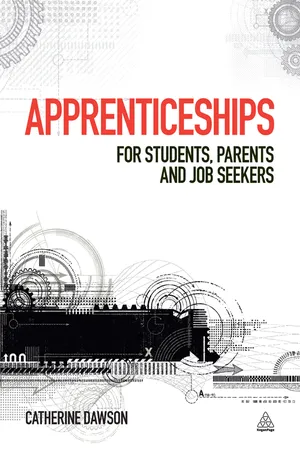Chapter One
The development of apprenticeships
Today apprenticeships are nationally recognized programmes designed by industry to equip young people and adults with practical skills for work. However, apprenticeships, in various forms, have been utilized for centuries as a means of passing on skills and trades from a ‘master’ to an apprentice (‘master’ could include both men and women, for example seamstresses took on apprentices). Indeed, early on in the development of apprenticeships it was illegal for someone to learn a craft without having paid the required fee to the authorities to become an official apprentice.
Rules and regulations have changed constantly over the centuries, usually in response to technological and political changes, eventually metamorphosing into the system that we see today. This chapter gives a brief history of apprenticeships and discusses the structure and framework of the current apprenticeship system.
History and background
The first official use of the term ‘apprentice’ was during the Middle Ages. Prior to this time workers had passed on their skills and knowledge to their own children and to local younger workers on an informal basis, without a specific system in place. However, as this system was based on private contract between apprentice and master it could be open to abuse by either party. Therefore, during the 14th and 15th centuries it was felt that some type of regulation was required to bring order to the system. For example, new regulations were introduced that meant that masters could no longer force their apprentices to carry out tasks outside their trade and apprentices were expected to be ‘obedient, industrious and orderly’ (Thomas, 1929).
In the Middle Ages apprentices tended to be aged 10 to 15 years. They would provide cheap labour in exchange for food, lodgings, necessary woollen and linen clothing, and training in a trade or craft. They had to agree to train for a minimum of seven years, after which they could progress to the positions of craftsman, journeyman, master and eventually grandmaster. Many apprentices, however, served for a much longer period and in some cases were almost ‘adopted’ by their masters (Thomas, 1929). This was often the case when masters would receive boys only from their own village or town.
Despite being self-employed, Belper nailers founded a kind of trade union with rules setting out conditions whereby young boys could enter the trade. So tight were the rules that only the children of established nailers could normally learn to be a nailer, an occupation he could only claim after seven years of apprenticeship. Despite being unionized, nailers were forbidden to buy stock rods from anywhere other than from approved nailmasters or factors, otherwise they faced a heavy fine. Anyone attempting to take on an apprentice from outside the closely linked family network could only do so by paying a premium of £20 to the union, a massive sum to a working class man in the 19th century.
Spencer, B (2011) ‘Belper Nailers’,
Country Images, March 2011, pp 34–35
In 1802 the Health and Morals of Apprentices Act was passed. Under this Act, new regulations covering working conditions and training for apprentices were introduced. This included the introduction of a 12-hour working day and the requirement that factory apprentices were taught reading, writing and arithmetic. It also instructed that male and female apprentices were to be provided with separate sleeping accommodation and that there should not be more than two apprentices to sleep in one bed. The Statute of Artificers and Apprentices, which had been introduced in 1563, had forbidden anyone from practising a trade or craft without first serving a seven-year period as an apprentice. However, this was repealed in 1814 so that practising a skill without being an apprentice was no longer illegal (National Apprenticeship Service, 2011).
CASE STUDY
I found details of my dad’s apprenticeship where he had dispensation in 1915 to leave school at 13 and start his engineering apprenticeship at a local firm. He stayed with the firm all his working life, ending up as the chief engineer for the factory. He again did what interested him, his hobby being a model engineer. So I had several nice working toys. The idea of being able to leave school early means you can learn what you need to learn as an apprentice without being bothered with all the other useless subjects being forced on you.
SOURCE Boots, Portland, apprentice 1955–60, via e-mail
As the 19th century progressed apprenticeships were expanded to include the emerging industries of engineering and shipbuilding, with plumbing, car mechanics and electrical apprenticeships introduced as technology progressed in the 20th century. Despite these new industries, apprentice numbers declined in the 1960s and 1970s. This was due, in part, to the increasing opportunities available in full-time education and the growing number of training schemes for young people (National Apprenticeship Service, 2011). Also, apprenticeships were criticized for providing limited opportunities for women and for not including many of the newer occupations that were emerging as the 20th century progressed.
CASE STUDY
Up to now we apprentices had a fairly easy time, as long as we were in the factory between 8 and 5 and looked as though we were doing something, we were pretty much left to our own devices… When Wellworthy took over, things changed dramatically. They sold the sports field which meant that my summer afternoons spent mowing it with the tractor and three-gang mower were at an end (in fact the tractor went too!). And we were all given specific responsibilities for part of the piston production line which they set up almost immediately. At 18 years old I had charge of part of a product line boring one-inch holes in pistons ‘manned’ by six women who were all about twice my age… I was very young and inexperienced for my a...



